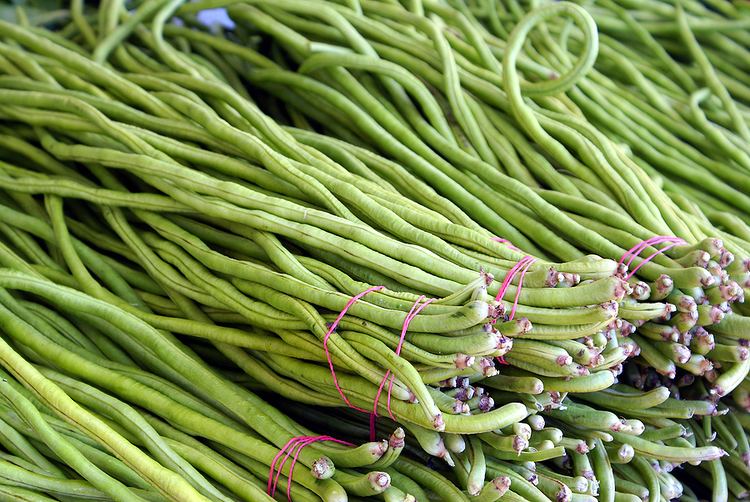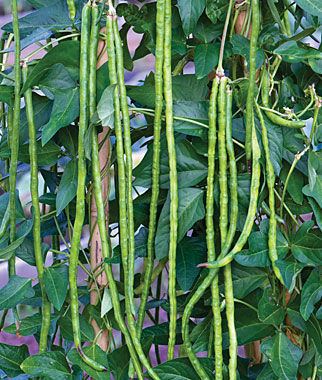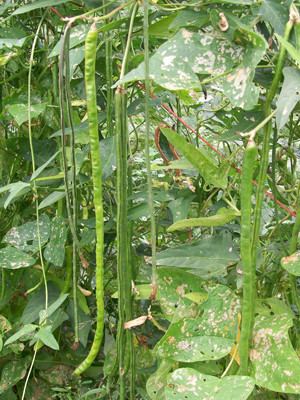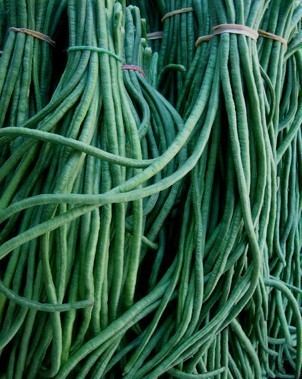Kingdom Plantae Family Fabaceae Genus Vigna Rank Subspecies | Order Fabales Subfamily Faboideae Higher classification Cowpea | |
 | ||
Scientific name Vigna unguiculata ssp. sesquipedalis Similar Water, Green bean, Water spinach, Tempeh, Bumbu | ||
Vigna unguiculata subsp. sesquipedalis is a legume cultivated to be eaten as green pods. It is known as the yardlong bean, bora, bodi, long-podded cowpea, asparagus bean, pea bean, snake bean, or Chinese long bean. Despite the common name, the pods are actually only about half a yard long; the subspecies name sesquipedalis (one-and-a-half-foot-long) is a rather accurate approximation of the pods' length.
Contents

This plant is of a different genus from the common bean. It is a vigorous climbing annual vine. The plant is subtropical/tropical and most widely grown in the warmer parts of South Asia, Southeast Asia, and southern China. A variety of the cowpea, it is grown primarily for its strikingly long (35- to 75-cm) immature pods and has uses very similar to that of the green bean. The many varieties of yardlong beans are usually distinguished by the different colors of their mature seeds. The plant attracts many pollinators, specifically various types of yellowjackets and ants.

The pods, which can begin to form just 60 days after sowing, hang in groups of two or more. They are best for vegetable use if picked before they reach full maturity; however, overlooked pods can be used like dry beans in soups. When harvesting, it is important not to pick the buds which are above the beans, since the plant will set many more beans on the same stem. The plants take longer to reach maturity than bush beans, but once producing, the beans are quick-growing and daily checking/harvesting is often a necessity. The plants produce beans until frost.

Uses

The crisp, tender pods are eaten both fresh and cooked. They are at their best when young and slender. They are sometimes cut into short sections for cooking uses. As a West Indian dish, they are often stir-fried with potatoes and shrimp. In Odisha, India, they are called ଝୁଡ଼ୁଙ୍ଗ [jhudunga], used to make a variety of dishes. Especially a sour dish - ଝୁଡ଼ୁଙ୍ଗ ବେସର [judunga besara] cooking along with mustard sauce and lime. They are also used in stir-fries in Chinese cuisine and Kerala cuisine.
In the Philippines, they are known as sitaw or butong and are widely eaten stir-fried with soy sauce, garlic, and hot pepper and in an all-vegetable dish called utan, or are stewed in bagoong-based dishes such as pinakbet and dinengdeng. Other Filipino dishes that have yardlong beans as ingredients are sinigang and kare-kare. Yardlong beans are also separated from the pod and are cooked with the buds of the alukon tree (Alleaenthus luzonicus) and other vegetables in a dish called agaya in northeastern Luzon.
In Malaysian cuisine, they are often stir-fried with chillies and shrimp paste (belacan) or used in cooked salads (kerabu). Another popular option is to chop them into very short sections and fry them in an omelette.
The plant is easy to grow in areas with hot and humid summers where other green bean varieties may succumb to heat damage in summer, and as such is worthy of more cultivation in these areas. This plant is particularly easy to grow in the Southeastern United States and southerly Midwestern United States, where it is not currently grown commonly.
In Suriname cuisine, they are called kousenband and served with roti. Similarly, in Trinidad and Tobago and Guyana (where it is known as bodi or bora) it is a Indo-Trinidadian/Indo-Guyanese dish that fried or curried and served with roti or rice.
In Khmer, the national language of Cambodia, they are called សណ្ដែកកួរ, IPA: [sɑndaek kuə].
Nutrition
They are a good source of protein, vitamin A, thiamin, riboflavin, iron, phosphorus, and potassium, and a very good source for vitamin C, folate, magnesium, and manganese.
A serving of 100 grams of yardlong beans contains 47 calories, 0 g of total fat, 4 mg sodium (0% daily value), 8 g of total carbohydrates (2% daily value), and 3 g of protein (5% daily value).
